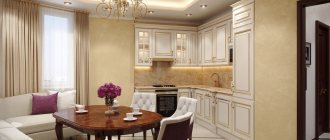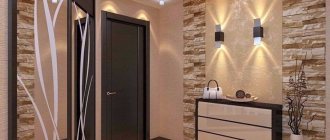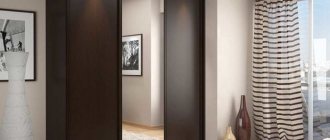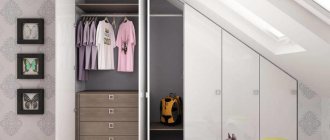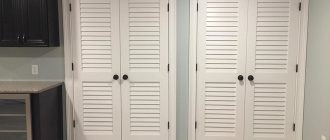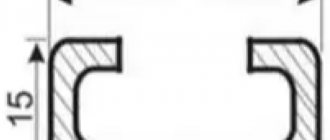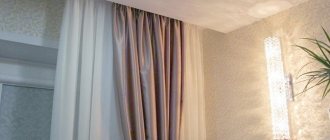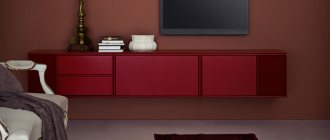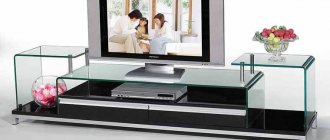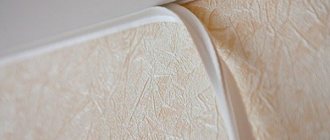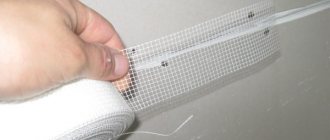Stretch ceilings in the modern world are deservedly popular due to their beauty, convenience, low cost and a host of other positive qualities. They are suitable for any ceiling surface and rooms for various purposes. The only drawback is that they reduce the height of the room.
After installing the stretch ceiling, the question arises about lighting the room. The selection of lighting fixtures and their diversity, as well as the pricing policy, are impressive. However, the LED strip has the greatest capabilities. It cannot heat up to such a state as to harm polymer materials. The proposed color range of such a product sometimes puts a person in an awkward position: the choice is so large that it is difficult to settle on something specific. Their durability, safety and damage resistance are enviable.
Brief characteristics of LED strips
Outdoor advertising shines brightly thanks to the built-in LEDs. They surround us everywhere: the interiors of entertainment and shopping facilities, simply for illuminating certain sections of roads. We are used to them and rarely pay attention to their presence. However, using them to illuminate a stretch ceiling is a unique idea. This is a great design decision.
The stretch ceiling consists of a transparent polyvinyl chloride film. If you strengthen the lighting fixtures underneath, the suspended ceiling will have beautiful decorative lighting. For these purposes, a decorative luminous tape will come in handy. It is not dangerous and does not get very hot. Its presence gives a soft and diffused light. Neither a chandelier nor other lighting elements can produce such an effect. Moreover, an LED strip placed around the perimeter of the room can serve both as a decoration element and as the main source of lighting. Moreover, LEDs consume several times less electricity than other lighting devices. And this significantly saves the family budget.
LED Strip Light
LED strips come in several types, the most common among them: SMD 3028 (3528) and SMD 5050 (5060). The latter option is superior in price, but it also has more power. The appearance of the diodes is different. The tapes also differ in the density of diodes on them. 1 meter of diode strip can contain from 30 to 120 LEDs. Moreover, the brightness directly depends on the number of diode elements located on the tape.
Types of LED strips
Another characteristic indicator of tapes is moisture resistance. If there is a degree of protection IP44 or more, this product can be used in rooms with high humidity, for example in swimming pools or bathrooms.
Video
We recommend watching a video that tells and shows how to mount a strip of LEDs around the perimeter of a plasterboard stretch ceiling:
In order to stick the tape as evenly as possible, use a masking cord and glue along its upper edge. Bend the tape carefully at the corners to avoid damaging it. At the final stage of installation, connect the power source and check that the backlight is working properly. Next, the tape is hidden using a polyurethane plinth.
Advantages of LED strip
To make a final decision on the choice of lighting sources, you need to thoroughly familiarize yourself with the positive qualities of the decorative tape. Its advantages are as follows:
| Fast payback | It is worth noting that the cost of LED strip is considerable. However, it is necessary to take into account the low energy consumption and calculate the savings. It will become clear how profitable such a product is. |
| Long service life | From the moment of installation it will last about 100,000 hours. Even with a constantly turned on light source, it will last for several decades. |
| Ideal lighting angle | The light dispersion of LEDs is 140 degrees. The result is soft and uniform lighting of the room. There will be no shadows in the room, which will allow photographers to take beautiful pictures without the use of expensive equipment. |
| Purity of shade | The diodes will give exactly the color you chose when purchasing the product. There is no need to apply additional filters for the desired shade. Moreover, throughout the entire service life, the lighting will not change color. |
| No strong heat | Thus, the stretch ceiling fabric does not heat up, which can lead to its deformation and sagging. The only light source that has such qualities. |
| Elasticity | It is possible to create a variety of figures and compositions, configurations of any complexity. |
| Unique Design Features | Makes the interior of the premises unique and inimitable. |
| Adjusting the light intensity | It is possible if the LED strip is connected to a dimmer. |
Types of LED strips
LED strips are available in two types:
- monochrome, which can produce one color;
- universal, which sparkle in a variety of shades. A special remote control is used for this.
Additionally, diode strips are divided into moisture-resistant, moisture-proof and moisture-proof. In dry rooms, such as offices, bedrooms, work rooms, you can use any type of tape, while in rooms with high humidity or in open space, you should give preference to moisture-proof options.
Types of built-in lighting for suspended ceilings
A suspended ceiling with built-in lighting is a luxurious, pleasant and elegant option to update your interior. All modern types of lamps are used for suspended ceiling structures.
- Spotlight lamp - suitable for illuminating a space at night and for separating or highlighting functional areas. This is one of the most budget-friendly lighting options.
- LED - has a long service life, provides the room with diffused light (uniform, illuminating all objects in the room).
- Classic - these are ordinary chandeliers that do not always fit into an interior with a suspended ceiling.
- Fluorescent lamps are great for economical and long-term use. Such lamps are often installed in non-residential public spaces. The only negative is that they are very sensitive to power surges in the network.
- Fiber optic - this type of lamp will create spectacular lighting for your room. Its cost cannot be called budget; it is quite expensive.
Which LED strip to choose for illumination
The choice of products is huge, but it is necessary to take into account the following characteristics of diode strips:
- The number of diodes placed on 1 meter of tape. The intensity of lighting depends on this. LEDs also vary in size - the larger, the brighter.
- The power indicator of the power source, which is predetermined. If we take the SMD5050 model, where there are 30 diodes, each of which will require 0.24 watts, then for a stretch ceiling, no more than 2 strips of 5 meters each (standard length) are taken. This makes 300 diodes (10 m x 30 diodes). 300 x 0.24 = 72W. Taking into account the small power reserve, installation of such an LED strip will require a power source of at least 100 W.
LED type Number of LEDs per meter Power consumption of one meter of tape, W SMD 3528 60 4,8 SMD 3528 120 9,6 SMD 3528 240 19,2 SMD 5050 30 7,2 SMD 5050 60 15 SMD 5050 120 25 - Voltage and power supplies. All diode strips are powered by 12 VDC. As a rule, the network contains 220 V AC. There is a need for a step-down transformer.
An example of connecting an LED strip to a step-down power supply - Availability of colors. Basically, manufacturing plants produce diode strips with RGB elements, where R is red, G is green, B is blue.
- Availability of controls. To change the light saturation in the room, use special remote controls. Thanks to them you can change the brightness of the lighting.
Preparatory work
Before starting installation work, you should consider a number of circumstances:
- Exact quantity of materials.
- Type of lighting, taking into account the required brightness of light and the presence of decorative elements.
- Power unit. This element of the system must be selected taking into account the required voltage, power and humidity in the room.
Note! If you need to change lighting colors in the future, you will need a controller.
Before starting installation, it is recommended to prepare the surface. To do this, you need to degrease the coating with solvent or alcohol and remove all defects from the surface. You can start working immediately after the surface has completely dried.
To do the job you will need a set of tools:
- ladder or reliable table;
- wire cutters;
- electric soldering iron (with a power of at least 25 W) and lead-tin solder;
- tweezers;
- hacksaw;
- pencil or marker, ruler (square);
- electric drill.
Backlight options
If we take it globally, there are only two types of lighting: external lighting of a stretch ceiling and internal. There are mainly four main methods of ceiling lighting:
| Diffused light around the perimeter | The most preferred option. In this case, the tape is placed on a special stand under the suspended ceiling. The light is directed upward and diffuses softly. |
| Directional backlight | Separate lampshades are mounted on slopes and directed to the ceiling surface. Visually, the resulting rays are directed along the canvas. |
| Curly lighting | The lampshades are placed in such a way as to create the appearance of various configurations. Inside the suspended ceilings there is a diode strip, which is laid in intricate shapes. |
| Spot lighting | The LED is mounted in such a way as to create spot lighting. This creates a “starry sky”. In this case, the light is directed downwards. |
Recommendations and tips
When choosing an installation method, focus on the height of the room; instead of a multi-tier structure, it is better to mount a floating ceiling, which visually increases the height.
A sky stretch ceiling with clouds looks great in small apartments; a canvas with such a print will also increase the apparent height of the room.
When determining the number of crystals per meter of tape, focus on the type of lighting:
- the main source requires 120 diodes/m;
- for perimeter lighting - minimum 30/m.
Degree of protection:
- IP 33 - for rooms with normal humidity;
- IP 67 or IP 68 - with wet and wet operation.
The color temperature also takes into account the purpose of the room: cold light is suitable for the bathroom or kitchen, warm light is suitable for the living room, bedroom, hallway.
List of required materials and tools
It is worth noting that for work related to the installation of LED strip, you must have certain tools, devices and materials available. The main and most necessary item is a soldering iron, the power of which does not exceed 25 W. In addition to this device, you must purchase:
- surgical forceps or tweezers. They will make it possible to use them to hold the wires being used;
- pliers for biting off wires or wire cutters;
- special devices used to strip insulation from wires;
- rosin or soldering flux;
- solder;
- heat-shrinkable tube;
- soldering acid;
- insulating tape with excellent adhesive properties;
- double-sided tape;
- effective solvent;
- high-quality synthetic glue;
- primer;
- devices for applying primer.
Installation
At the first stage, the ceiling niche structures are installed to accommodate the lamps. The height of the structure must be sufficient for the height of the lamp base. Electrical wiring is placed inside and becomes completely hidden behind the surface of the ceiling.
Holes are made in the ceiling for spotlights. Strip LEDs are placed in a special profile fixed to the surface of drywall. To create a diffused glow, the profile with the tape is covered with frosted glass. Neon strip lights do not require a glass profile or screen; they simply need to be secured using fasteners in several places.
Preparing the LED strip for installation
Before installing the LED strip, you should decide on the number of LEDs on it and their density. If there is a need to illuminate certain areas of the room with tape, then use type SMD3528 (60 diodes per 1 meter) or SMD5050 (30 diodes per 1 meter). If the LED strip will be the main source of lighting, then strips with diodes from 60 pieces per 1 linear meter are purchased. (SMD5050) or from 120 pieces per 1 linear meter. (SMD3528).
Once the diode density is determined, the required tape footage is set. The total power of the diode strip is taken into account and the appropriate power source is selected. In the absence of proper experience in this matter, it is best to seek help from a consultant in the store, who will offer the best option based on different power supplies for different tapes.
Power supplies for LED strip
As a rule, the cut points of 3 LEDs are determined on the tape. When using a simple tape, the soldering occurs “+” and “+”, or “-” and “-”.
Soldering LED strips together
If you decide to use RGB tape, then you should solder it based on the labeling requirements. The wires included in the kit are usually soldered by buyers. Preference is given to stranded wires due to their greater reliability. In this case, tips with a 0.75 mm cross-section are attached to the reverse ends. Special clamps are used for this. Experts do not recommend using teeth or pliers for these purposes. The result is that the wires have better contact with the controller, dimmer, and power supply. Afterwards, the contacts inserted into the block are secured with screws.
Connector for LED strips
As soon as the soldering of the wires to the LED strip is completed, a special heat-shrinkable tube is put on it. This will increase the safety of the lighting device, since the contacts will receive additional insulation and the strength of the connections will improve.
Installing heat shrink tube onto tape
The standard length of LED strip is 5 meters. It is rolled into a bobbin. If additional length is needed, the tapes in the reels are cut and then connected to each other. The main point is taking into account the power of the power source that will be used.
How to cut LED strip correctly
The steps to connect LED strips with an amplifier are as follows:
- The amplifier performs almost the same functions as the controller. If the controller does not have enough power and the LED strip is not completely installed, an amplifier is installed.
- The number of amplifiers can be any, depending on how long the LED strip will be installed and how much power is required for its operation. You can connect the tape to a power source in different ways.
The principle of connecting RGB strips to amplifiers and controllers
Useful videos on the topic:
Semi-hermetic blocks
How to dismantle a suspended ceiling yourself and install it back
If you are not satisfied with any of the above options and you do not intend to overpay, then pay attention to the third type of blocks. These are semi-hermetic models
In English they are called Rainproof, although they do not provide full protection from rain.
Therefore, you cannot place them directly on the street in the open air. Here the moisture protection index is IP54.
Where can they be installed? They are ideal for the following premises:
large warehouses
attics
garden gazebos
utility and unheated rooms
roofs
These semi-sealed units have a protective housing and a lid that opens easily to allow access to all the internals. There are ventilation holes on the sides.
But unlike simple drilled “holes” in unsealed specimens, these holes are protected from drops in the form of a convex slope.
The main design feature of such power supplies is the presence of a built-in internal fan.
For example, in unsealed blocks, the fan is installed in powerful units, starting from 300W.
In the same models, built-in cooling is already available in devices with a power of only 60W.
The lack of cooling holes has to be compensated for by forced airflow. Also, the microcircuit itself is filled with transparent epoxy material.
Their significant drawback is noise. Therefore, their use in residential areas is not recommended.
Also, with the same power, they have the largest dimensions among all other power supplies. Therefore, to hide such a box, you will have to carefully look for a suitable place, or make a separate area.
You can choose suitable power supplies from trusted Chinese comrades:
leaky - tutā
Slim models - here
sealed - from here
How to install LED strip under a suspended ceiling
Many people try to place LED strips in such a way that they are not visually noticeable. It is enough to have outgoing soft and uniform lighting. The main ways to install LED strips are as follows:
- A metal frame structure is mounted under the ceiling.
- As soon as the surface is primed and puttied, a cable is laid for the wires of the LED strips.
- Those areas where the LED strip will be installed are thoroughly cleaned and degreased.
- The tape is attached to the ceiling cornice using construction tape. Power supplies are located in places where the ceiling structure is reinforced.
- Next, the suspended ceiling is installed.
The standard mounting method is to use a ceiling cornice. With this installation, the tape will not be visible. The main stream of light is directed to the ceiling, and its reflection fills the room. There is an alternative mounting option - behind the baseboard. The principle of room lighting is identical.
Recommendations from experts! If there are suspended ceilings in the room, the LED strip is placed at a distance of at least 2 cm from the surface of the ceiling covering.
Step-by-step instructions for installing LED strips to the ceiling
Useful videos about installing LED strips under suspended ceilings:
Installation sequence
The procedure for performing operations when installing lighting in the kitchen is as follows:
- Cut the tape into pieces of the required length.
- Solder 2 wires to the terminals. Here you need to strictly observe polarity, so it is better to take wires of different colors. For example, we draw a red wire from the “+” terminal, and a black wire from the “-” terminal.
- We isolate the soldering area. It is better to do this using heat shrink tubing. It is pulled over the contact point so that it extends 3-4 cm from it on both sides. After this, it is thoroughly warmed up with a hair dryer. This insulation looks neat, and the quality of protection is high.
- We mark the holes on the furniture, drill them with a drill, and screw the aluminum profile onto the screws.
- We glue a strip of double-sided tape inside the profile. We attach the tape to the second side.
- We screw the transformer into place. It is worth attaching a piece of wire with a plug to it in advance. This attachment is made to the terminals of the primary winding, which will be supplied with 220 volts from the household electrical network.
- The circuit is assembled, the wires from the tape are soldered to the terminals of the transformer. Controls are attached.
The diagram is assembled. All that remains is to connect the power and check its functionality.
Installation instructions
During the installation process, it is necessary to follow certain rules in order to achieve maximum performance of the circuit and eliminate the need for frequent repairs later.
It is better to buy LED strip with maximum protection from moisture. It fits entirely into a silicone tube. This tape costs a little more. However, if you consider that the kitchen is a place where there is always a risk of water droplets, such costs will not be unjustified.
Places where the tape can be cut are marked on it with special icons. It is prohibited to cut the tape in other places, since then it is impossible to guarantee its uninterrupted operation. After trimming, the contacts are cleaned from the silicone tube. To be able to solder safely, you need approximately 15 mm of clean space.
It is better to connect wires to the tape by soldering. It is easier to achieve connections with connectors, especially for multi-color tapes that have a lot of wires in the control circuits. But the quality of the connection will be poor; if the wires are kinked, they may simply break. Connectors are better suited for connecting pieces of tape.
Power supplies should be selected with a power reserve. It should be approximately 20% of the required power (it is calculated by the number of diodes). Such a reserve will allow the unit not to operate in extreme conditions, which will extend its service life.
Features of installing LED strips under the ceiling
You cannot mount an LED strip to illuminate a ceiling surface without using wires and power supplies. The process of installing this type of lighting is not particularly difficult and does not require special knowledge or little experience in this area. But there are certain nuances that it is not enough to know about. They still need to be taken into account during the installation process.
- First of all, the length of the LED strip and the required power to service it are calculated. Purely mathematical calculations: the power of 1 linear meter of strip is multiplied by its total length.
- It is strictly forbidden to connect more than 2 pieces (10 meters) of strip in series. If the rooms are large and this amount of lighting material is not enough, it is necessary to use the parallel connection method. You can purchase multiple power supplies. Moreover, an additional unit is required if the total power is more than 40W.
Parallel connection diagram for LED strips - When choosing a backlight with multi-colored reflection, in addition to the power supply, an RGB controller is also installed, thanks to which you can change the color scheme.
Connection diagram for RGB strips - It is not recommended to install an LED strip without pre-treatment with a primer.
- The principle of gluing the tape is quite simple: the protective layer is removed and the tape is pressed onto the selected areas.
- The last step is to connect to the power supply and check the operation of the entire system.
- After carrying out a complex of works, the vinyl sheet of the stretch ceiling is stretched.
Video on how to connect an LED strip to a power supply:
Connectors
The factory equipment of the tape, completely ready for installation, assumes the presence of connectors connected to the electrical power source.
However, the cut elements do not have ready-made contacts, so the use of connectors with connectors is the only correct option for connecting a lighting device.
The cost of the connector varies greatly depending on the functional purpose.
Connector devices can be not only connecting, but also connecting and feeding devices, designed for connection to devices such as a power source, controller or dimmer.
Soldering LED strip
Installing an LED strip is not difficult. However, many are put off by the need to solder it. These actions should be taken in cases where the length of the purchased tape exceeds the required one or one sheet is clearly not enough for a large room. For complex figures, the tape rotates many times and changes direction, which also requires cutting it. Afterwards, the contact points must be reconnected. You shouldn’t immediately look for professionals – electronics engineers. Just get started by purchasing connecting wires or connectors.
Soldered RGB strips
Using connectors for LED strip
Connecting LED strips using connectors is much easier than soldering them, but this option has its drawbacks.
The principle of connecting the connector and LED strip
When a connector is used, there is a small contact area between the contact on the connector and the contact on the tape, which can cause heat. LEDs located in the immediate vicinity of this place may lose their brightness and differ from other diodes, which will negatively affect the uniformity of the backlight. Moreover, in the absence of soldering and tinning, copper will darken over time, then oxidize, forming a green coating (oxides) that prevent the passage of current. When the contacts are heated significantly, oxidation occurs much faster. The result is that the diodes will begin to blink and eventually go out. Even if the contact area is somehow increased, future oxidation may still occur. Therefore, if possible, you should opt for soldering.
Required tools for soldering
Soldering is not as difficult as it seems at first glance. It is necessary to have a general understanding of the work. Materials worth stocking up on:
- rosin;
- neutral flux - gel;
- low power soldering iron;
- thin copper wires;
- toothpicks;
- stripper or knife;
- tin-lead solder.
How to solder LED strip
Brief instructions for carrying out the work look like this:
- We are preparing a soldering iron.
- We dip it in rosin.
- Then we lower it into the solder.
- We dip it in rosin a second time.
- We solder the wires and tape.
Angle or 90 degree rotation
Peeling begins first in the corners at the turning points or along the edges. Therefore, these attachment points should be taken more seriously from the very beginning.
If you simply bend the strip at a 90 degree angle and try to secure it that way, it will definitely cause it to peel off.
An air gap will form in the corner, and straight sections of the tape will exert tensile forces.
What can be done in this case? For example, cut the tape and get the perfect 90 degree angle, or whatever angle you need.
The connection of individual segments is made either by soldering.
Or inexpensive connectors.
Not everyone likes cutting a solid tape, and we can agree with that. Therefore there is another way.
Instead of the usual 90 degree bend, make a loop.
Yes, you will still have a piece of tape that is not glued to the surface, but there will be no effort trying to tear off other straight sections.
How is this loop made? Instead of bending the strip in the desired direction, turn it in the opposite direction and make one turn.
Although here, as usual, there is a drawback. All recommendations for working with LED strips prohibit bending it in any direction, as this negatively affects the integrity of the copper tracks.
Therefore, which option is better - cutting or looping - is up to you to decide based on your specific situation.
How to mount an LED strip under a ceiling plinth
This option does not accept the use of mirror or glossy film, otherwise all the mounted elements that are located behind it will be visible. Often, separate lampshades or an LED strip are used to illuminate curtains or curtains. To do this, a small box , and the ceiling is stretched from below.
Installation of tape under a box with a suspended ceiling
Video about installing tape in a niche under curtains:
It is necessary to proceed from the fact that LED strip is used mainly for illumination. Therefore, the multi-level ceiling part is designed in such a way that other lighting devices , such as lamps and chandeliers, are placed on it so that there is enough light in the room. A chandelier is usually placed in the very center of the room. Lampshades can be placed anywhere. The main thing is that they look good and are functional.
The backlight can be mounted in different ways. It all depends on the person’s skill, his imagination and capabilities. The main point is that the ceiling must be in harmony with the rest of the room and be completely safe for others from a fire safety point of view.
It must be borne in mind that absolutely all lighting devices heat up to one degree or another during operation. Therefore, the suspended ceiling should be located at some distance from them. This will make it possible to avoid deformation of the ceiling covering and fire.
To be able to remotely control the RGB system, you need to purchase and connect an additional unit. As a rule, the delivery is completed with a special plastic or metal case, which is designed to mount the power supply and control unit. This design is attached inside the box using self-tapping screws so that it is not visible from below.
Strip lighting under a suspended ceiling is installed after preliminary cleaning of the mounting location from dust and dirt. If this is not done, the tape will not hold. Immediately before installation, the protective paper is removed from the tape, but not more than 1 meter. If the strip is completely freed from the protective layer, then dust and dirt will quickly settle on it, and you won’t have to wait for the tape to be securely attached to the surface. During operation, the tape freed from the protective layer may touch other surfaces, and the LEDs may stick together. Then the installation process will be seriously difficult. Therefore, you need to handle the protective layer carefully, without haste, and remove it in small parts as you attach the LED strip to the box.
If during the installation process there are extra centimeters of tape left, do not hastily cut them off. It must be borne in mind that the strip can only be divided in those places that are marked in the form of a perpendicular strip, and it passes every 3 to 5 diodes.
After completing the installation process of the diode strip, the end that is equipped with a connector is connected to the power supply. If there are no such connectors in the cut section, you must fill the gap and solder them yourself. Key point: don't get confused with polarity. If the connection is incorrect, the entire system will fail.
To facilitate work related to the replacement or repair of lighting fixtures, it is advisable to place the power supply and control unit in areas of the box where they can be reached without causing damage to the structure. When installing an LED strip around the entire perimeter of the room, certain difficulties may arise in this matter. Then it is advisable to install the blocks outside such a room.
Recommendations from experts! In order for the equipment to work for a long time and with high quality, it is worth choosing products from Western or Korean companies. Chinese products do not differ in quality and durability.
After completing the installation work, it is necessary to check the operating condition of the circuit. To do this, you need to turn on the power supply. If there are no questions about the lighting, the functionality of the remote unit is checked in various modes. If you are convinced that everything is working properly, you can begin installing the stretch ceiling.
Advantages and disadvantages
Much can be said about the advantages of LED backlighting, its advantages are:
- safety;
- ease of installation;
- durability;
- the ability to implement any design solutions;
- visual appeal;
- efficiency.
The disadvantages of the system are associated with the short service life of the LEDs - 5-7 years, because of this it is recommended to choose a more repairable installation of LEDs below the suspended ceiling, otherwise repairs will require dismantling the entire structure. Also, when installing lighting on a wall, the height of the room decreases by 10 cm, which is significant for standard multi-apartment housing.
